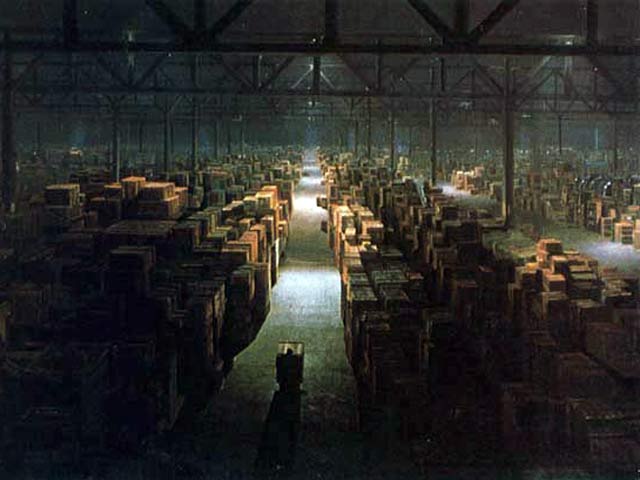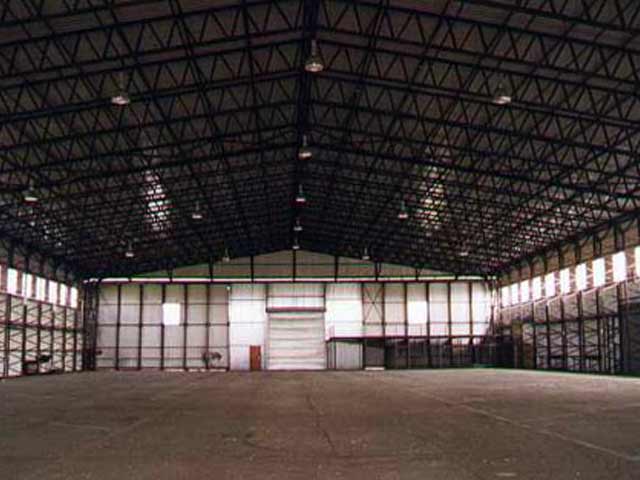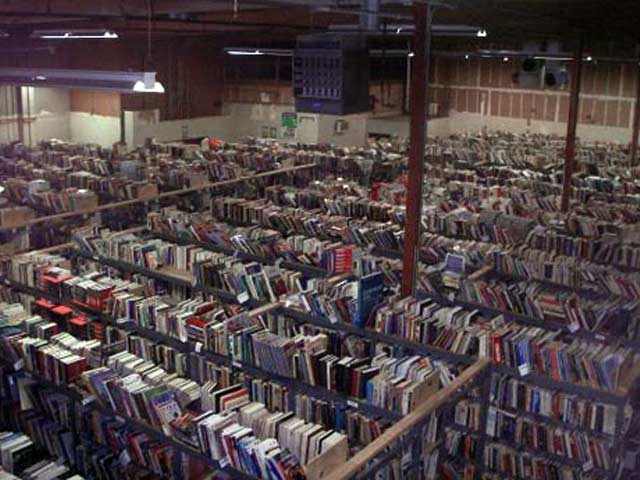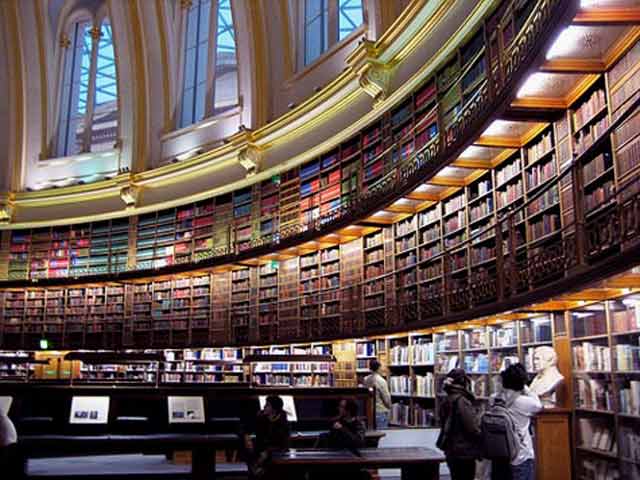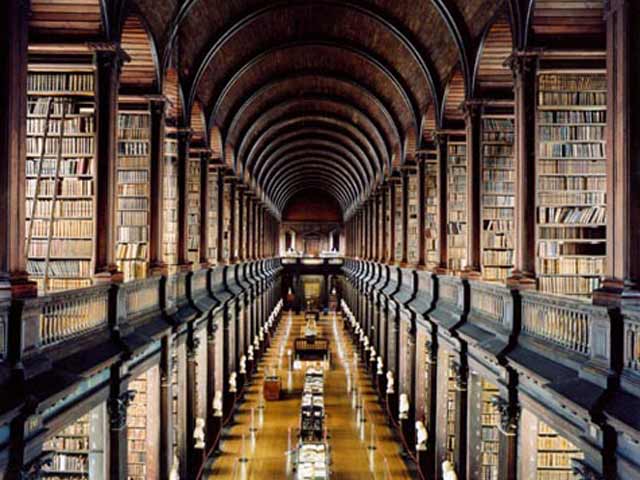What No One Is Reading
The Future Warehouse of Unwanted BooksWithout libraries what have we? We have no past and no future. - Ray Bradbury by Geoff Manaugh A warehouse is being constructed to house the books that no one's reading.
The unforgettable final glimpse of a US government warehouse from Raiders of the Lost Ark "The warehouse is extraordinary," the Guardian writes, "because, unlike all those monstrous Tesco and Amazon depositories that litter the fringes of the motorways of the Midlands, it is being meticulously constructed to house things that no one wants." [Those fringes are outside London.] "When it is complete next year, this warehouse will be state-of-the-art, containing 262 linear kilometres of high-density, fully automated storage in a low-oxygen environment. It will house books, journals and magazines that many of us have forgotten about or have never heard of in the first place." The building's temperature will be regulated. It will be sealed against moisture. It will hold copies of books that no one actually cares about. Indeed, this is where unwanted books "will go to serve their life sentences in a secure environment," the Guardian explains, "thanks to the grace of the provisions of the 1911 Copyright Act [UK] and later government legislation." In other words, a relatively random piece of 100-year old legislation - dealing with copyright law, of all things - has begun to exhibit architectural effects. These architectural effects include the production of huge warehouses in the damp commuter belts of outer London. These aren't libraries, of course; they're stockpiles. Text bunkers.
Text bunker From the Guardian):
We thus learn that "low use material" is being relocated "from rented warehouses in London to a cheaper facility where the material will be kept in conditions that ensure it is kept as pristine as possible" - and that this move, along with all the "mind-bending logistical problems" inherent in such a task, are simply par for the course in our era's ongoing format wars. In other words, should we be saving books, CDs, PDFs, MP3s...? And do we know that anyone will ever use them? I'm tempted to say that we need an injection of Buddhism - or, at least, the doctrine of non-attachment - into the field of library science. But I'm not a Buddhist, so I'm not going to say that. (Interesting, though, that religious beliefs could affect both the shape and the very existence of libraries). In any case, last month Anthony Grafton took a long look at the future of the library, gazing upon the history of textual accumulation from the Library at Alexandria to Google's new book-scanning project. Grafton said, "When ships docked in Alexandria, any scrolls found on them were confiscated and taken to the library. The staff made copies for the owners and stored the originals in heaps, until they could be catalogued. At the collection’s height, it contained more than half a million scrolls, a welter of information that forced librarians to develop new organisational methods. For the first time, works were shelved alphabetically." Of course, then the Library at Alexandria burned down.
Proof libraries still exist Enter the printing press: The rise of printing in 15th-century Europe transformed the work of librarians and readers. Into a world already literate and curious, the printers brought, within half a century, some 28,000 titles, and millions of individual books - many times more than the libraries of the West had previously held. Reports of new worlds, new theologies, and new ideas about the universe travelled faster and more cheaply than ever before. And, of course, huge new structures took shape, specifically built to house this growing surplus. This surplus was really the archive, and this archive keeps civilisation going, with all of its awareness of the past. Or so we're told.
The British Library Reading Room: via Wikimedia (go there for a larger view)
Photo by Vlad Jesul Fast-forward, then, to the present and you'll find even more gigantic air conditioned warehouses under almost continual construction on the sides of Western motorways - and you get some sense of how the quest for unrestricted information retrieval has taken on architectural form. No matter if no one actually visits these places; they're our era's equivalent of pharaonic tombs. They're time capsules. Quoting once again from the article by Grafton: "Though the distant past will be more available, in a technical sense, than ever before, once it is captured and preserved as a vast, disjointed mosaic it may recede ever more rapidly from our collective attention." Perhaps it will take some future moment of cultural archaeology to break into these places, spelunking back into the literate past, to find well-tempered rooms still humming at 50ºF, humidity-free, where the past is refrigerated and Shakespeare's name can still be recognised on the spines of books. Until then, these warehouses - again, not libraries - will continue to take shape as abstract windowless volumes outside cities on the freeway.
The library at Trinity College, Dublin Finally, though, I'm reminded of a few lines from The Name of the Rose by Umberto Eco, in which the book's narrator and his well-read "master," William of Baskerville, break into a labyrinthine library after dark - a library full of mirrors, unmarked halls, and trick doorways. (While lost in the library, the narrator beautifully remarks: "I proceeded as if in the grip of a fever, nor did I know where I wanted to go.") The architects of the library were, in fact, quite clever, mixing climate control with acoustic design:
"In any case," the book goes on, "we need two things: to know how to get into the library at night, and a lamp." After all, the narrator then says, "I felt inclined to disobedience and decided to return to the library alone. I myself didn't know what I was looking for. I wanted to explore an unknown place on my own; I was fascinated by the idea of being able to orient myself there without my master's help." And so he goes, lamp in hand, heading into that unlit space full of books that no one's reading, in a surround-sound of breezes, looking for something he knows he'll never find. Source: bldgblog.blogspot.com 1 December 2007
For IT-related articles on snooping, usage, the future, e-diaries, piracy, flickers, cyborgs, browsing, trends, jokes, philosophic agents, artificial consciousness and more, press
the "Up" button below to take you to the Index page for this Information and Technology section. |
 Animals
Animals Animation
Animation Art of Playing Cards
Art of Playing Cards Drugs
Drugs Education
Education Environment
Environment Flying
Flying History
History Humour
Humour Immigration
Immigration Info/Tech
Info/Tech Intellectual/Entertaining
Intellectual/Entertaining Lifestyles
Lifestyles Men
Men Money/Politics/Law
Money/Politics/Law New Jersey
New Jersey Odds and Oddities
Odds and Oddities Older & Under
Older & Under Photography
Photography Prisons
Prisons Relationships
Relationships Science
Science Social/Cultural
Social/Cultural Terrorism
Terrorism Wellington
Wellington Working
Working Zero Return Investment
Zero Return Investment